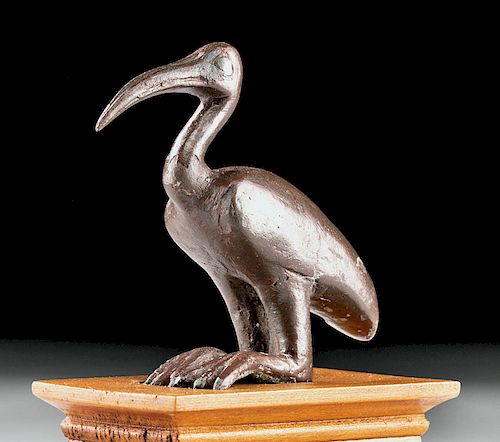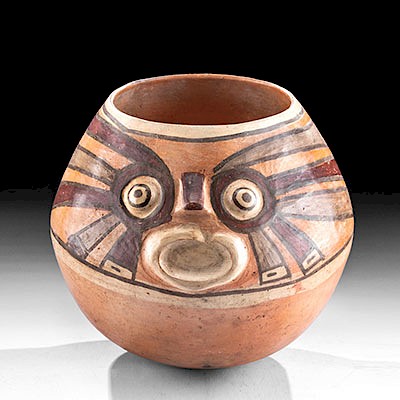Fine Egyptian Ptolemaic Bronze Standing Ibis Statuette
Lot 5a
About Seller
Artemis Gallery
686 S Taylor Ave, Ste 106
Louisville, CO 80027
United States
Selling antiquities, ancient and ethnographic art online since 1993, Artemis Gallery specializes in Classical Antiquities (Egyptian, Greek, Roman, Near Eastern), Asian, Pre-Columbian, African / Tribal / Oceanographic art. Our extensive inventory includes pottery, stone, metal, wood, glass and textil...Read more
Categories
Estimate:
$4,500 - $6,500
Absentee vs Live bid
Two ways to bid:
- Leave a max absentee bid and the platform will bid on your behalf up to your maximum bid during the live auction.
- Bid live during the auction and your bids will be submitted real-time to the auctioneer.
Bid Increments
| Price | Bid Increment |
|---|---|
| $0 | $25 |
| $300 | $50 |
| $1,000 | $100 |
| $2,000 | $250 |
| $5,000 | $500 |
| $10,000 | $1,000 |
| $20,000 | $2,500 |
| $50,000 | $5,000 |
| $100,000 | $10,000 |
| $200,000 | $20,000 |
About Auction
By Artemis Gallery
Dec 5, 2019
Set Reminder
2019-12-05 10:00:00
2019-12-05 10:00:00
America/New_York
Bidsquare
Bidsquare : Ancient / Ethnographic - Holiday Edition
https://www.bidsquare.com/auctions/artemis-gallery/ancient-ethnographic---holiday-edition-4710
What to give this holiday season? Ancient & Ethnographic Art of course! Our special Holiday auction features hundreds of unique finds from all over the world. Artemis Gallery info@artemisgallery.com
What to give this holiday season? Ancient & Ethnographic Art of course! Our special Holiday auction features hundreds of unique finds from all over the world. Artemis Gallery info@artemisgallery.com
- Lot Description
Egypt, Ptolemaic Period, ca. 332 to 30 BCE. A cast-bronze statuette of an ibis posed as if standing in the shallow waters on the shores of the Nile. The petite figure presents with large, webbed feet drawn beneath its plump body, its neck curved up and back in an S-shape, and its avian countenance delineated with circular eyes and a long, curved beak. Typical ibis figures like this example are displayed atop lengthy rectangular plinths and usually with a smaller human in front of it, either representing a supplicant to the ibis-headed god Thoth or another deity like Maat. Size: 3.2" L x 0.9" W x 2.9" H (8.1 cm x 2.3 cm x 7.4 cm); 4.4" H (11.2 cm) on included custom stand.
The ibis, an elegant, long-legged wading bird that lives along the shores of the Nile River, was associated with Thoth, the ibis-headed god of wisdom, writing, and other intellectual pursuits. Many thousands of ibises were ritually sacrificed in honor of Thoth and were embalmed, mummified, and placed within underground galleries as offerings. Thousands of these burials have been excavated at Sakkara, near Memphis, Egypt's ancient capital. Smaller bronze ibis statuettes like this example were typically votive items to be placed inside a tomb with other offerings for the deceased in their journey to the afterlife.
A strikingly similar example, of a larger size, hammered for GBP 16,250 ($20,917.00) at Christie's, London "Antiquities" auction (sale 14230, July 5, 2017, lot 21).
Provenance: private Orange, California, USA collection; ex-collection of Philip Mitry, noted antiquarian in Cairo before 1950
All items legal to buy/sell under U.S. Statute covering cultural patrimony Code 2600, CHAPTER 14, and are guaranteed to be as described or your money back.
A Certificate of Authenticity will accompany all winning bids.
We ship worldwide and handle all shipping in-house for your convenience.
#150812Copper-brown resurfacing material across most surfaces, with chips to areas beneath feet, around tail, and on head and beak. Repairs to both legs and feet and reattached to body. Nicks and minor abrasions to legs, body, and head, with light softening to some facial details, and light encrustations beneath feet. Great patina on exposed areas.Condition
- Shipping Info
-
All shipping is handled in-house for your convenience. Your invoice from Artemis Gallery will include shipping calculation instructions. If in doubt, please inquire BEFORE bidding for estimated shipping costs for individual items.
-
- Buyer's Premium



 EUR
EUR CAD
CAD AUD
AUD GBP
GBP MXN
MXN HKD
HKD CNY
CNY MYR
MYR SEK
SEK SGD
SGD CHF
CHF THB
THB














